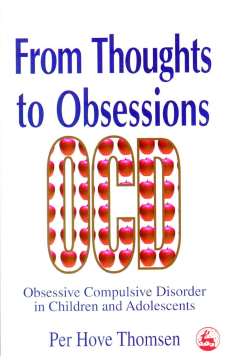
Additional Information
Book Details
Abstract
This introductory book explains the nature and treatment of OCD in children and adolescents. Written for parents and relatives as well as doctors, teachers and other professionals working with this group of patients, it defines OCD and forms a straightforward explanation of the symptoms, assessment procedures and treatment strategies.
Per Hove Thomsen is a specialist in child psychiatry who has, for a number of years, worked with the research and treatment of obsessive behaviour in children and adolescents. He is Head of the Research Centre at the Child and Adolescent Psychiatric Hospital in Århus, Denmark.
The book displays the warmth and understanding that the author has for young people with OCD, describes the need for increased awareness and recognition of this illness, and would provide a reasonable starting point for someone learning about paediatric OCD.
`This introductory book, richly illustrated with case examples, explains the nature and treatment of OCD in children and adolescents. Written for parents and relatives as well as doctors, teachers and other professionals working with this group of patients, this book defines OCD and forms a straightforward explanation of the symptoms, assessment procedures and treatment strategies.'
Autism-Europe Link
`By far the best chapters are those derived from the author's clinical experience, particularly a good account of the significant social problems experienced by those with severe OCD. There is a helpful chapter on obsessive symptoms as part of normal development, and a reasonable account of differential diagnosis. He reviews some of his own ideas, such as that of co-existent `empathy disorder', which he describes in 25% of young people with OCD. Overall, the book displays the warmth and understanding that the author has for young people with OCD, describes the need for increased awareness and recognition of this illness, and would provide a reasonable starting point for someone learning about paediatric OCD.'
European Journal of Child and Adolescent Psychiatry
`…it is a compact book, easy to understand and helpful as an overview of OCD.'
Napot Journal
`Per Hove Thomsen's brief, clear and accurate book places Obsessive Compulsive Disorder, a condition that is still poorly understood and often missed in young people, within a spectrum… it acknowledges the torment experienced by the children and adolescents who are suffering from the disorder, as well as their families. As Thomsen says, it is important to see that the young person is the victim of an illness, which needs treatment. The book describes the illness in a way that is accessible to a wide audience of parents, teenagers and teachers. The numerous case studies will help to reduce young people's sense of isolation, and increase their understanding of their condition. Thomsen keeps psychiatric jargon to a minimum and carefully explains the terms that he does use. His emphasis on the disturbing thoughts that victims suffer is particularly helpful and likely to reduce the fear of insanity that is often a great burden to them.'
Times Educational Supplement Special Needs
Table of Contents
| Section Title | Page | Action | Price |
|---|---|---|---|
| From Thoughts to Obsessions: Obsessive Compulsive Disorders in Children and Adolescents | 3 | ||
| Contents | 5 | ||
| Foreword | 7 | ||
| 1 The Definition of OCD | 9 | ||
| 2 Earlier Attitudes to OCD | 13 | ||
| 3 The Clinical Picture | 15 | ||
| 4 How Common is OCD? | 33 | ||
| 5 Cultural Aspects of OCD | 39 | ||
| 6 Obsessive Features as Part of Normal Development | 43 | ||
| 7 The Course of OCD | 49 | ||
| 8 OCD Seen in Relation to Other Mental Illnesses during Childhood and Adolescence | 59 | ||
| 9 The Treatment of OCD | 79 | ||
| 10 What are the Causes of OCD? | 95 | ||
| 11 How Can One Determine Whether a Child has OCD? | 101 | ||
| 12 Epilogue | 107 | ||
| Appendix I: Children’s Yale-Brown Obsessive Compulsive Scale (CY-BOCS) | 109 | ||
| Appendix II: International Classification of Obsessive Compulsive Disorders | 137 | ||
| Appendix III: Diagnostic Criteria for Obsessive Compulsive Disorder | 139 | ||
| References | 141 | ||
| Subject Index | 147 | ||
| Author Index | 151 |
